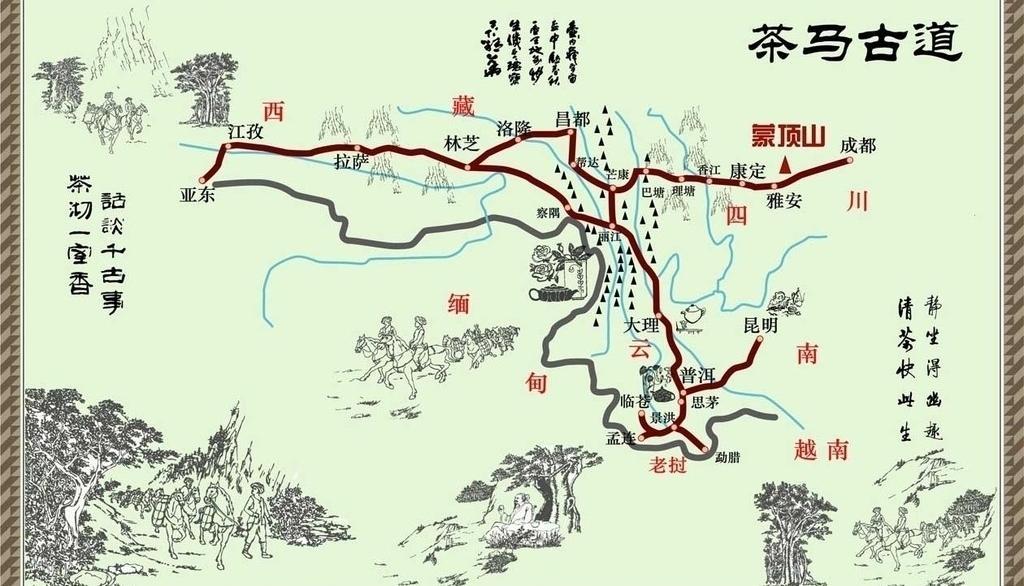반응형
#바라보기, Tea Horse Road, Ancient Tea Route/Southern Silk Road, 茶馬古道, 차마고도
#Tea Horse Road, Ancient Tea Route/Southern Silk Road
#茶馬古道
#차마고도
The Tea Horse Road or Chamadao (simplified Chinese: 茶马道; traditional Chinese: 茶馬道), now generally referred to as the Ancient Tea Horse Road or Chamagudao (simplified Chinese: 茶马古道; traditional Chinese: 茶馬古道) was a network of caravan paths winding through the mountains of Sichuan, Yunnan and Tibet in Southwest China.[1] This was also a tea trade route. It is also sometimes referred to as the "Southern Silk Road" or "Southwest Silk Road."

There are numerous surviving archaeological and monumental elements, including trails, bridges, way stations, market towns, palaces, staging posts, shrines and temples along the route.[2]
"Ancient Tea Horse Road" is a historical concept with a specific meaning. It refers to a major traffic road formed by the exchange of tea and horses between Han and Tibet from the Tang and Song Dynasties to the Republic of China.
#Shaanxi-Gansu Tea Horse Road
Shaanxi-Gansu Tea Horse Road (陕甘茶马古道) is the main road for tea in mainland China to travel west and exchange for horses. It is one of the main routes of the ancient Silk Road.[3]
#Tanggu Road
Beginning in the Han dynasty, the Tanggu Road (蹚古道) was formed by Shaanxi merchants and the ancient tea-horse market in the southwest frontier. Since the government of the Ming and Qing dynasties imposed government control on tea sales, tea sales were divided into regions, and the most prosperous tea and horse trading market was in Kangding.[3]
#Yunnan-Tibet Tea Horse Road
The Yunnan-Tibet Tea Horse Road (滇藏茶马古道) was formed in the late sixth century AD. It started from Yiwu and Pu'er in Xishuangbanna, the main tea producing area of Yunnan, and entered Tibet through today's Dali Bai Autonomous Prefecture, Lijiang City and Shangri-La, and went directly to Lhasa. Some were also re-exported from Tibet to India and Nepal, which was an important trade route between ancient China and South Asia.[3]
#Sichuan-Tibet Tea Horse Road
The Ancient Sichuan-Tibet Tea-Horse Road (川藏茶马古道) is a part of the Shaanxi-Kangding-Tibet Tea-Horse Road. It starts from Ya'an, the tea producing area of Yazhou in the east, passes through Dajian Furnace (now Kangding), reaches Lhasa, Tibet in the west, and finally leads to Bhutan, Nepal and India. More than a thousand kilometres, it is an indispensable bridge and link between ancient Tibet and the mainland.[3]
Sichuan and Yunnan are believed to be the first tea-producing regions in the world.
The first records of tea cultivation suggest that tea was cultivated on Sichuan's Mount Mengding [zh] between Chengdu and Ya'an earlier than 65 BC. Ya'an has been an important hub of tea trading till the 20th century.
From around a thousand years ago, the Tea Horse Road become a trade link from Yunnan to Tibet; and to Central China via Sichuan Province.[3][4][5][6][7] It is believed that it was through this trading network that tea (typically tea bricks) first spread across China and Asia from its origins in Pu'er county in Yunnan.[8][9] The route earned the name because of the common trade of Tibetan ponies for Chinese tea, a practice dating back at least to the Song dynasty, when the sturdy horses were important for China to fight warring nomads in the north.[10]
Both people and horses carried heavy loads. Tea porters sometimes carried over 60–90 kg (132-198 lb.), which was often more than their own body weight in tea.[11][12][13] Porters were equipped with metal-tipped staffs, both for balance while walking and to help support the load while they rested, so they didn't need to lay the bales down (as illustrated in the photo).
In addition to tea, the mule caravans carried salt and silk products from Chengdu, notably shujin (蜀锦; a type of Sichuan embroidery).
#茶馬古道
茶馬古道係舊時中國西南部貿易嘅路徑,主要範圍包括咗四川、雲南同貴州一帶,有啲商路重可以通到去南亞。因為交易最多嘅貨係茶葉,又要依靠馬嚟行山路運貨,所以就叫「茶馬古道」
茶馬古道是可與「絲綢之路」相媲美的中國古代商業路網,位處於中國西南部的橫斷山區與青藏高原之間,起自中國四川省的成都、雅安,雲南省的昆明、普洱等地,終點為西藏的拉薩以及東南亞等地。路網遍布今四川省、雲南省、貴州省和西藏自治區,橫跨長江(金沙江)、瀾滄江、怒江及雅魯藏布江等四大流域,是內地漢族地區與其他民族經濟往來的一種重要方式,為中國西南地區各民族間互通有無,進行經濟、文化交流的紐帶。
根據文獻記載,茶馬古道大約形成在西漢時期,其形成與中國茶文化的發展,傳播有密不可分的關係。
另有一說,茶馬古道是中國軍隊對馬的需求,和西藏對茶的愛好,在11世紀時所形成的跨越青藏高原的貿易路線,並延續到1950年代為止
由於中國西南部,氣候溫暖濕潤,適宜茶葉生長,而且雲南地區的人民還保留了製作壓茶的方法及傳統,這種壓製的茶葉(以普洱茶為代表),方便運輸,儲藏,為馬幫將茶葉運入藏區提供了條件。在以游牧業為主的西藏高原地區,這裡的人民以肉食為主,因為環境的制約,他們的飲食中缺乏蔬菜,這樣,他們需要從茶馬古道運來的茶葉,用來補充人體生存必須的維生素。
除茶葉、馬匹外,由茶馬古道運進藏區的還有瓷器、絲綢等物品,而中國對馬匹的需求在18世紀開始降低後,運出高原的貨物則以羊毛、黃金、白銀、藥材等為主。所有貨品的運輸都是依靠馬幫在高原與山區間往返。
在古代,有很多鄉鎮都是為了招待馬幫而形成。
茶馬古道
古代中國西南地區商貿通道
茶馬古道,是指唐代以來,為順應當地人民需求,在中國西南和西北地區,以茶葉和馬匹為主要交易內容,以馬幫為主要運輸工具的商品貿易通道,是中國西南民族經濟文化交流的走廊。[13][16]
茶馬古道是以川藏道、滇藏道與青藏道(甘青道)三條大道為主線,輔以眾多的支線、附線,構成的一個龐大的交通網絡。地跨陝、甘、貴、川、滇、青、藏,外延達南亞、西亞、中亞和東南亞各國。[1][16]茶馬古道主要幹線主要分南、北兩條道,即滇藏道和川藏道。[3]茶馬古道的存在推動了各民族經濟文化的發展,凝聚了各民族的精神,加強了各民族間的團結。[2]茶馬古道是推動民族和睦、維護邊疆安全的團結之道。[13]茶馬古道是中國統一的歷史見證,也是民族團結的象徵。[1]
2013年3月5日,茶馬古道被中華人民共和國國務院公佈為第七批全國重點文物保護單位。[9]-baidu
#中文名
#茶馬古道
#外文名
#Tea Horse Road
所處時代
唐至民國
保護級別
第七批全國重點文物保護單位
開放時間
全天
차마고도(茶馬古道, Ancient Tea Route/Southern Silk Road)는 중국과 티베트, 인도를 잇는 전근대의 무역로이다. 중국의 윈난성, 쓰촨성에서 시작되어 티베트를 거쳐 인도의 벵골과 네팔 등으로 이어진다.-위키백과
'마방(馬幇)'이라 불리는 상인들이 말과 야크를 이용해 중국의 차와 티베트의 말을 서로 사고팔기 위해 지나다녔다. 이곳을 통해서 문화의 교류도 활발하였다. 해발고도 4,000m가 넘는 험준하고 가파른 길이지만 경치가 매우 아름다운 길로 유명하다. 2007년 KBS에서 6편으로 구성된 차마고도에 관한 다큐멘터리, 《인사이트 아시아 - 차마고도》를 제작하면서 한국에 널리 알려졌다.
차마고도(茶馬古道)의 길들은 크게 여덟 개 노선으로 나뉘며, 마방들이 주로 이용하던 곳은 아래의 두 가지 경로이다.
#윈난성
시솽반나(西雙版納), 쓰마오(思茅), 다리(大理), 리장(麗江), 샹그릴라, 더친(德欽) - 티베트 - 네팔 - 인도
#쓰촨성
야안(雅安), 다두허, 캉딩(康定), 더거(德格) - 티베트 - 네팔 - 인도
쓰촨성은 차마사(茶馬司)라는 관청을 두어 국가가 주도하던 곳이었다.
《인사이트 아시아 - 차마고도》(Asian Corridor In Heaven, 이하 《차마고도》)는 한국방송공사(KBS)에서 제작, 방영된 6부작 다큐멘터리로, 2007년 9월 초부터 2007년 11월 말까지 방영되었다. 차마고도의 모습과 그 곳에 살아가고 있는 사람들의 생활상을 세계 최초로 TV 다큐멘터리에 담아내었다. 차마고도에서의 촬영을 성공시키기 위해 차마고도 전 구간에 3개의 촬영팀을 동원했으며, 약 1년 4개월 간의 촬영기간이 소요되었다. 12억원 이상이 이 프로그램을 제작하는 데 사용되었다.
방송 이후 2008년에 열린 제4회 KBS 프리미어 영화 페스티벌에서 《천상의 길 차마고도》라는 제목으로 기존 6편의 차마고도를 압축한 약 60여 분의 극장판 버전이 상영되기도 했다.
2008년 10월에는 대한민국 다큐멘터리로서는 최초로 《차마고도 - 마지막 마방 편》이 에미상 다큐멘터리 부분 최종 수상 후보에 올랐다.
방송 회차
1부 : 마지막 마방 (2007년 9월 5일)
2부 : 순례의 길 (2007년 9월 6일)
3부 : 생명의 차(茶) (2007년 10월 20일)
4부 : 천년 염정 (2007년 10월 21일)
5부 : 히말라야 카라반 (2007년 11월 24일)
6부 : 신비의 구게 왕국 (2007년 11월 25일)
#바라보기, Tea Horse Road, Ancient Tea Route/Southern Silk Road, 茶馬古道, 차마고도
반응형
'松泉, 바라보기, 인생글, 좋은글, 취미생활' 카테고리의 다른 글
| 바라보기,좋은글, 이산혜연선사 발원문, 5초만 투자하기 (7) | 2025.04.15 |
|---|---|
| 바라보기, 언어, 숨겨진 것 XX ,20 (6) | 2025.04.15 |
| 바라보기, 언어, 숨겨진 것 XIX ,19, 스님은 왜 ?? (22) | 2025.04.13 |
| 바라보기, 2024, 전통등 전시회, 연등, 빛, 길, 동행, 부처님 오신날 (132) | 2025.04.13 |
| 바라보기, Steve Job's 2005 Stanford Commencement Address, 스티브잡스 스탠포드 졸업연설 (4) | 2025.04.13 |